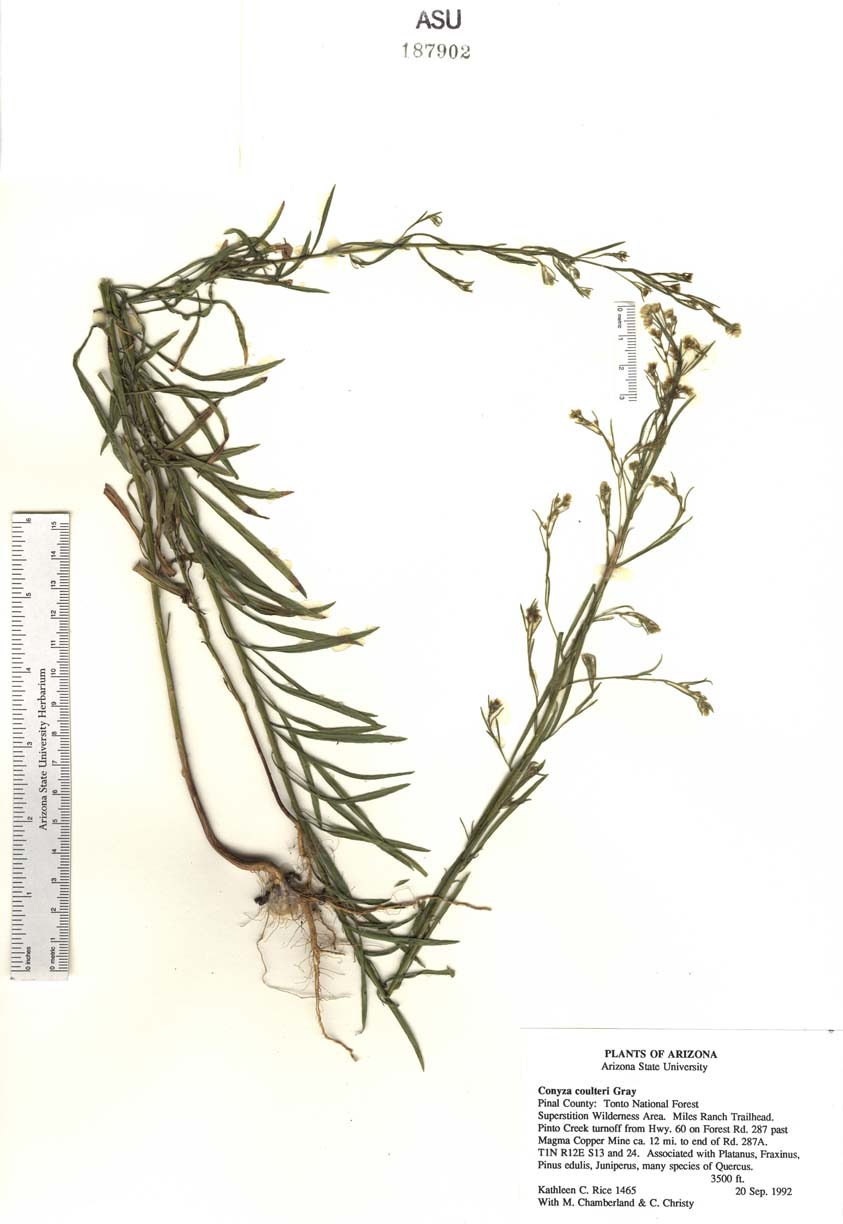Conyza
|
Family: Asteraceae |
Annuals [perennials], 10-120(-350+) cm. Stems usually erect, branched mostly distally (spreading and branched throughout in C. ramosissima), glabrous or hispid, hispidulous, strigillose, or strigose. Leaves basal and cauline (mostly cauline at flowering); alternate; petiolate or sessile; blades mostly lanceolate to oblanceolate or linear, margins rarely lobed, ultimate toothed or entire, faces usually hispid, hispidulous, strigillose, or strigose (eglandular). Heads radiate or disciform, usually in spreading to strict, paniculiform or corymbiform arrays (borne ± singly in C. ramosissima). Involucres ± turbinate, 2-5[-7+] mm diam. Phyllaries 20-40+ in 2-4 series, appressed (usually reflexed in fruit), the larger usually 3-nerved (midnerves orange to brownish; not notably keeled), lanceolate to linear, unequal, ± herbaceous medially, margins membranous, abaxial faces glabrous or hirsutulous, hispidulous, or strigose. Receptacles ± flat, pitted or smooth, epaleate. Peripheral ('ray') florets pistillate, fertile: either 20-45+ in 1-2+ series, corollas white to purplish (filiform with laminae filiform to elliptic, 0.1-1[-1.5+] mm), or 20-150+ in 2-5+ series, corollas ochroleucous (filiform, laminae lacking, distally truncate or 2-5-toothed). Disc florets 3-30+, bisexual, fertile; corollas yellowish (nerves sometimes prominently resinous), tubes shorter than narrowly funnelform throats, lobes 5, erect or spreading, deltate; style-branch appendages deltate. Cypselae compressed, oblong to elliptic, 1-nerved on each edge, faces glabrous or strigillose (hairs 0.05-0.1+ mm), eglandular; pappi persistent, of 15-25+ pinkish, sordid, tawny, or white, ± equal, barbellulate, apically attenuate bristles in 1 series. x = 9. Distinctions between Conyza and Erigeron, as usually circumscribed in the past 50+ years, are not always clear. Usually, conyzas have unequal (graduated) phyllaries and 2-20+ times as many pistillate florets as bisexual florets in each head (rarely more bisexual than pistillate), and corollas of pistillate florets either lack laminae or have laminae usually less than 1(-1.5) mm. Erigerons usually have subequal phyllaries and more bisexual than pistillate florets (rarely more pistillate than bisexual) and corollas of pistillate florets (if any) usually have laminae 2-10+ mm. In studies by R. D. Noyes (2000) and by Noyes and L. H. Rieseberg (1999), Conyza, as traditionally circumscribed, was found to be nested within Erigeron and to be para- and/or polyphyletic. Here, absent an alternate taxonomy, four species traditionally treated in Conyza are retained in Conyza and a separate suite of six species that have usually been included in Conyza are treated in Laënnecia.
Invol bracts ±imbricate, scarcely herbaceous; pistillate fls numerous and slender, without rays, or in some spp. (all ours) with very short, narrow, and inconspicuous white or purplish rays barely or scarcely exceeding the pappus; disk-fls few, in ours not more than ca 20; style-appendages short, as in Erigeron; receptacle flat or nearly so, naked; achenes 1-2-nerved, or nerveless; pappus of capillary bristles, sometimes with a short outer series; herbs, often weedy, with alternate lvs and several to many, mostly rather small heads. 50+, mainly trop. and subtrop. Gleason, Henry A. & Cronquist, Arthur J. 1991. Manual of vascular plants of northeastern United States and adjacent Canada. lxxv + 910 pp. ©The New York Botanical Garden. All rights reserved. Used by permission. |

